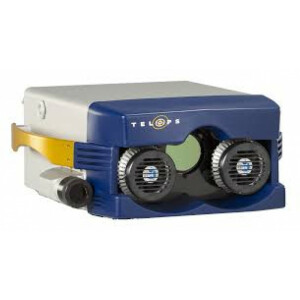

High-Speed Infrared Cameras Used to Measure Fire Turbulence
Wildfire spreads by pre-heating unburnt fuels (vegetation) using a combination of radiative and convective heating processes. In rapidly spreading grass or stubble wheat fuels, turbulent wind flow aids to intermittently convect the heat produced by combustion onto the unburnt fuels leading to its ignition and fire spread. In a way, the fire is sustaining its motion, but the role of atmospheric turbulence, its intensity, and scale is a fundamental player in the unpredictability of fire spread. In order to better understand the generated turbulences, a Telops infrared camera was used to capture images of controlled stubble wheat burn from an elevated position.
The research objectives are:
1. Establish and verify the use of high-speed infrared cameras for real fire turbulence measurements.
2. To characterize the spatial and spectral information of Coherent Turbulence Structures
3. Understand hot air parcel individual and group kinematics in relation to fire and/or atmospheric forcing
Experimenting with Stubble Wheat Burns
“Burn plots were established near Darfield, New Zealand to measure atmospheric turbulence structure and scales, heat transfer, and flame characteristics on spreading line-fires in cereal crops. These crop stubble fuels, with their even row spacings and uniform cut height, provide the best real-world approximation of the laser-cut cardboard fuel arrays used in the laboratory experiments.”1

Figure 1 Burn #1 (left). Burn #2 (right).
Field burning was carried out during March 2018. Two burns were done, the first at 14:00 LST and the second at 10:30 LST (Figure 1). Fires were ignited with drip torches from multiple line segments along the upwind edge to allow a linear flame zone to develop and spread across the plot under the prevailing wind (Figure 2a).

Figure 2 (a) Aerial image of the experimental burn showing the linear flame zone spreading from simultaneous line ignitions along a fire break. (b) Elevated platform. (c) Cameras installed on the elevated platform.
Air turbulence and temperature characteristics as the fire passed were measured by a 10 m tower near the centre of each plot with sonic anemometers at 2m, 5m, and 10m along with an array of 20 thermocouples installed at intervals along the vertical pole (Figure 3). The frequency and distance of forwarding flame bursts were measured using 5m horizontal arrays of fine-wire thermocouples each separated by 0.2m.

Figure 3 (a) Image of the field showing the horizontal array of 32 fine-wire thermocouples positioned 20cm appart (b) and the 10m tower with sonic anemometers and vertical array of 20 fine-wire thermocouples positioned 50cm appart (c).
Remote sensing of the burn experiments was accomplished using a variety of tools including a high-resolution Telops FAST IR camera (refer to Figure 4). The objective was to position the camera above the spreading fire line and capture high-speed brightness temperature changes induced by the fire, the hot air parcels surrounding the fire, and when we can, the heat perturbations on unburnt fuels.
The camera used for this project was the FAST-IR L200 camera, a high frame rate infrared camera operating in the longwave (LW) band from 7.7 μm to 9.3 μm. This camera is perfectly designed to analyse dynamic and spectrally rich events.
Thanks to their cooled 640 x 512 pixels sensor, this high-performance infrared camera is also extremely sensitive (NEdT of 22mK), enabling the detection of tiny temperature changes on challenging targets. The camera produces thermal images at rates of up to 234 fps in full-frame mode or up to 17 200 fps in sub-windows. It features our unique proprietary real-time calibration outputting data in NUC or temperature units greatly simplifying the use of the camera without compromising accuracy. With unique features such as automated exposure control (AEC) and enhanced high dynamic-range imaging (EHDRI), scientists benefit from the ease of use and operation flexibility while getting accurate measurements over the entire camera’s operation range.
Results of the Experiment
During the fires, wind speeds varied between 6 to 10 m/s. The fire rate of spread among plots varied from about 40 m/min to over 100 m/min, with flame lengths of approximately 1m to 5m. Collected data suggest that these field-scale stubble fires were consistent with laboratory results that convective heating plays a crucial role in heating fuel particles to ignition in wind-driven wildland flame spread. In-fire and high-speed IR video revealed intermittent flame bursts contacting fuel particles 1 to 5 metres forward of the ignition interface.

Figure 4 (a) Image from the in-fire visible camera showing the horizontal array of thermocouples. Readings from thermocouple #1 for burn case 1 (b) and burn case 2 (c).
Figure 5 presents cross-correlation values of thermocouple and brightness temperature data from the IR camera. The brightness temperature signal compares well with in-situ thermocouples in time and frequency. Figure 6 presents an example of a spatial and temporal temperature distribution threshold analysis to extract hot air parcel size distributions using Image Segmentation (classical and simple) and Image Correlation (TIV) methods. The Image Segmentation analysis consisted of the application of a temperature distribution threshold for defining features and then
using image segmentation to identify centres of structures defined by a spatial gradient of a property field. Thermal Image Velocimetry (TIV) consisted of the calculation of the advection velocity of individual pixels from correlations across time (frames) and space (interrogation windows). The quality and stability of the images allows for good turbulent signal extraction and studying hot air parcel kinematics.
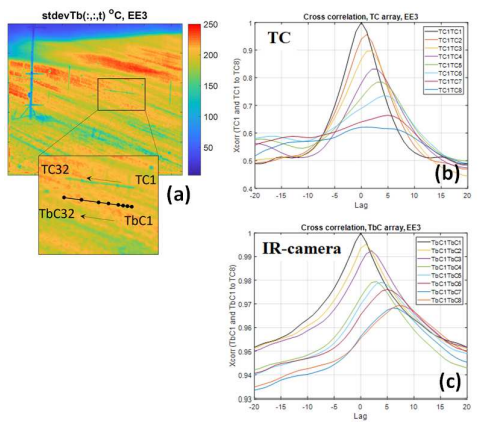
Figure 5 (a) Infrared image showing the location of horizontal thermocouple array. (b) Cross-correlation for thermocouple array. (c) Cross-correlation for brightness temperature from IR camera.
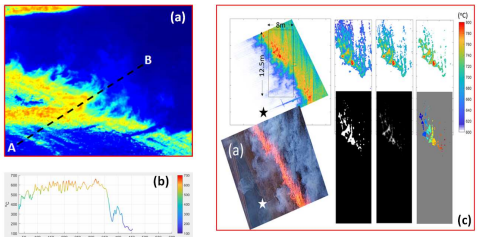
Figure 6 (a) Brightness temperature image of fire flames and flaming zone. (b) Brightness temperature across line [AB] coloured by degree Celsius. (c) Hot air parcel identification process for subsequent thermal image velocimetry.
Conclusion
The high-speed infrared camera can capture fire brightness temperature perturbations that represent hot air-parcel turbulence. Brightness temperature signal compares well with in-situ thermocouples in the time and frequency domain. Streamwise flaming zone dynamics appear to correlate with fire front activity. Moreover, crosswise flaming zone dynamics reveal lower frequency waveforms compared to streamwise components. Further analysis is needed to understand the possible role of near-surface wind speed/turbulence on flaming zone dynamics.
Acknowledgements
We would like to give a special thanks to all field support teams including volunteers and technical staff, the New Zealand rural fire fighting team, and the local landowner for their various contributions leading to the success of the field campaigns. This research was funded by the Ministry of Business, Innovation and Employment (MBIE), New Zealand, grant number CO4X1603 entitled “Preparing New Zealand for Extreme Fire.
References
[1] Pearce, H. & Finney, Mark & Strand, Tara & Katurji, Marwan & Clements, Craig. New Zealand field-scale fire experiments to test convective heat transfer in wildland fires. (2019).
[2] Tremblay, P. & al. Pixel-wise real-time advanced calibration method for thermal infrared cameras. Proc. SPIE 7662. (2010).
Do you have questions about this case study?
Get in touch with Telops, and they would be happy to answer any questions you have about pricing, suitability, availability, specs, etc.

Related products

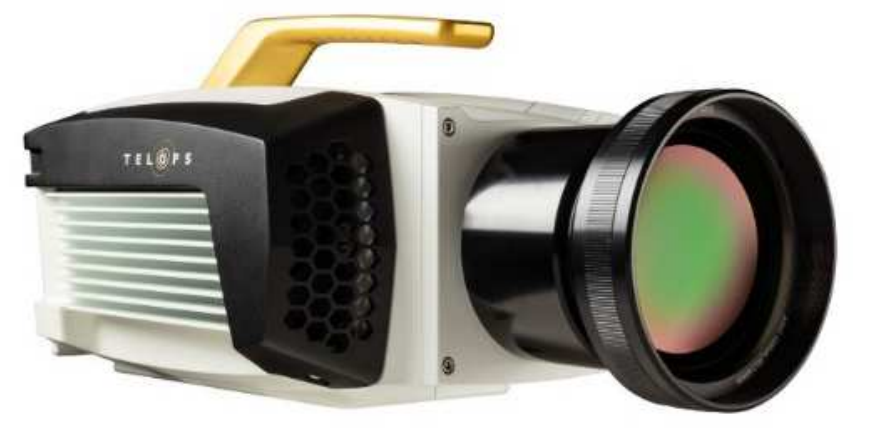
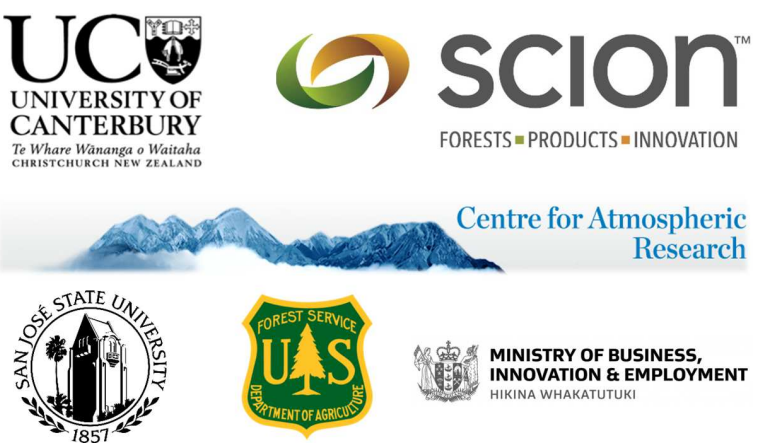
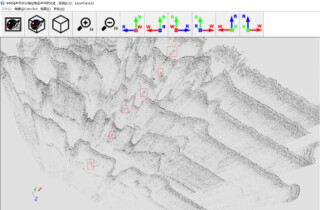

![3月21日-封面[1].jpg](https://cdn.geo-matching.com/voeE1ywo.jpg?w=320&s=6b3b1a0215d770f8797653e9202a8f52)




